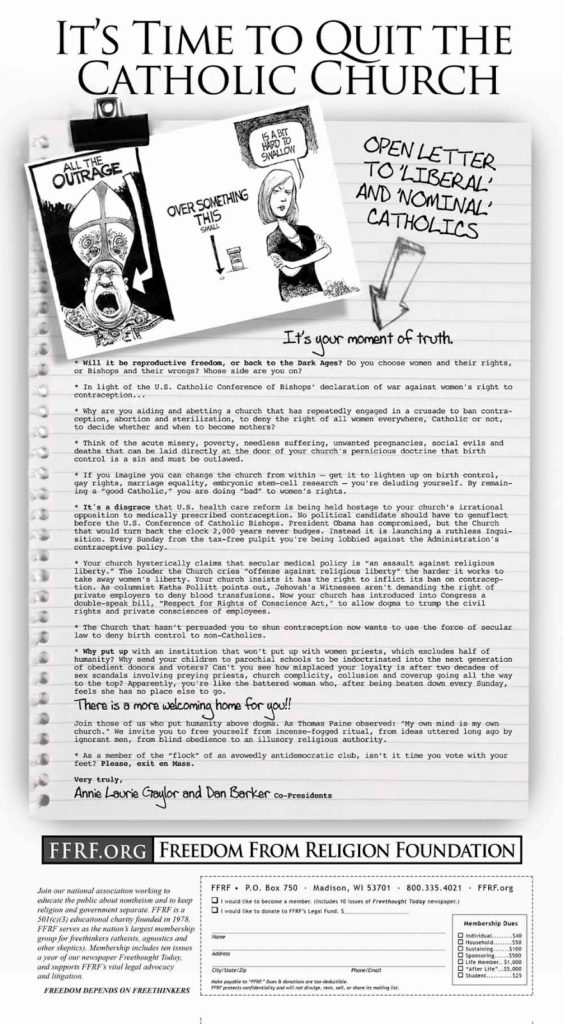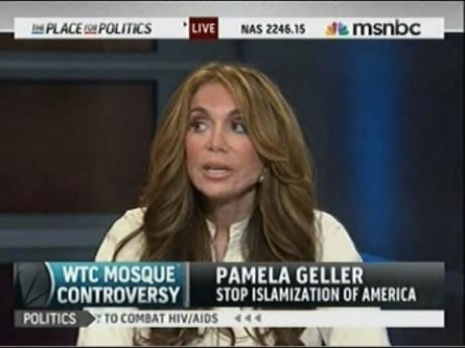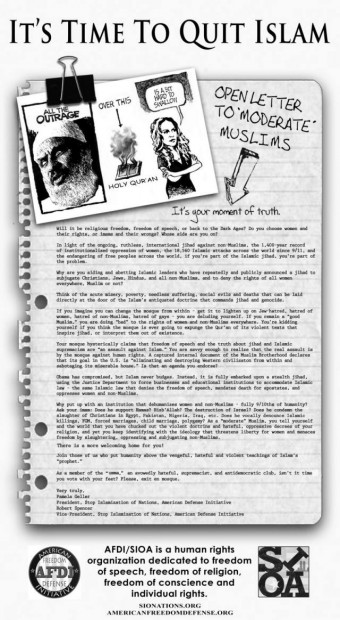Amy Levin: The New York Times committed a liberal faux pas last month. As if they’d forgotten just how controversial ads can be, they accepted $39,000 from the Freedom From Religion Foundation (FFRF) to run a full-page. . .well I’ll just say it, “anti-Catholic” advertisement. The ad features a political cartoon–with a grumpily outraged male bishop and a frustrated cosmopolitan, white, middle-aged female sandwiching a birth control pill–that reads, “All the outrage over something like this is a bit hard to swallow.” Next to the cartoon in giant bold letters the ad visually screams “Open letter to ‘liberal’ and ‘nominal’ Catholics. It’s your moment of truth.” Feast your eyes down the page and you’ll find any number of quintessential reasons to leave the Catholic church, most prominently, women’s reproductive rights. Here’s a fun clip:
Why put up with an institution that won’t put up with women priests, which excludes half of humanity? Why send your children to parochial schools to be indoctrinated into the next generation of obedient donors and voters? Can’t you see how misplaced your loyalty is after two decades of sex scandals involving preying priests, church complicity, collusion and coverup going all the way to the top? Apparently, you’re like the battered women who, after being beaten down every Sunday, feels she has no place else to go. There is a more welcoming home for you! Join those of us who put humanity above dogma. . .
As a member of ‘the flock’ of an avowedly antidemocratic club, isn’t it time you vote with your feet? Please, exit en Mass.
Alright, let’s get this straight. By continuing affiliation (whatever this means as a lived experience) to a Catholic church, liberal Catholics are like abused women, seemingly devoid of physical and emotional agency which has been stolen by their manipulative abuser, the Catholic church. In this scenario, we might say that the Times is the silent-nodding-along-psychoanalyst. But the story doesn’t end there – we have more victims and perpetrators.
Shortly after the ad hit the stands, the famously outspoken director of Stop Islamization of America, Pamela Geller (view her blog Atlas Shrugs here), asked the Times to run a parallel ad (for the exact same price FFRF paid) that urges liberal-to-moderate Muslims to shed whatever loose ties they yet have to Islam. Though the aim of her provocation was transparent, Geller’s inkling was spot on: the Times refused to run the ad, hoping to placate recent tensions over the burning of Qur’ans on a military base in Afghanistan and subsequent civilian fatalities. In response to this refusal, Geller told FoxNews.com that, “This shows the hypocrisy of The New York Times, the ‘gold standard’ in journalism, and its willingness to kowtow to violent Islamic supremacist intimidation.” (Click here to view Geller discussing this “double-standard” on “Fox and Friends.”)
While media coverage of these ads has once again unfortunately retracted back to a cultural tug-of-war over Islam in America, there’s a much more interesting story behind the fine print of the first most un-holy of ads. Over at GetReligion, editor Terry Mattingly gets it. He asks, “Here’s the key question: Why DO so many doctrinally liberal people remain members of the Catholic Church? Why don’t they do the logical thing and join, oh, a visually Catholic Episcopal parish down the block?” Mattingly wisely offers the mic to a professor and theologian from Fordham University, Tom Beaudoin, researching what he calls “deconversions” among “secular Catholics.” In a blog post at America Magazine, Beaudoin claims that the anti-Catholic ad points to a particular cultural moment in which secular Catholicism is gaining a certain type of legitimacy and literacy. He writes:
The ad trades on the newly widespread awareness that Catholicism is shedding adherents: that most Catholics live on the “lower” end between moderate and marginal affiliation, instead of high affiliation, and that a great many are actively disaffiliating. It trades on the widely understood distance between most Catholics’ beliefs and practices and official teaching on certain matters. Most important, as far as I can tell, is its remarkably confident appeal to a kind of personal agency that would make Catholics, who so often see religion as something akin to an ethnicity, walk away from it.
This discussion opens up a much more interesting conversation (I think) about what it means to identify oneself as an American Catholic, and what that lived experience looks like. As my editor, Ann Neumann, likes to point out, the media often fails to acknowledge that 98% of Catholic women use some form of contraception–despite leadership’s absolute abnegation of any form of birth control. After the contraception coverage battles earlier this year, the difference between church “law” and church-going lives should be ancient news; there is no shortage of articles recently claiming just how diverse the Catholic population actually is. And, to plug my own thesis topic, the fact that the FFRF felt the need to load their moral gun (and with so much green ammo) toward liberal Catholics shows that there might just be something substantive and distinctly different about liberal Catholics. As Beaudoin writes:
But some of the deconversion literature would suggest that when people do walk away from their faith/religion/religious community, they don’t only want “freedom from religion.” Some switch to another religious denomination or even another religion, some hang loose and nurture a religious/spiritual life apart from active affiliations with recognized religious communities, some let go of faith/religion/spirituality altogether, and some hang on within their religious community and struggle more or less openly with it.
Beaudoin’s research makes the term “secular Catholic” a bit more comprehensible. In fact, in Mattingly’s recent piece on the “Rise of the ‘secular Catholics’” he interviews Beaudoin. According to the professor, secular Catholics are “people who were baptized as Catholics, but they find it impossible to make Catholicism the center of (their) lives, by which I mean Catholicism as defined by the official teachings of the church.” But don’t let the term “secular” fool you, because it is these Catholics who Mattingly claims the FFRF ad is going after.
Regardless of how many Catholics Pew Research Center claims are leaving the church, it seems that much of the media is missing why both the FFRF and conservative Catholics are up in arms about liberal Catholics: they exist! And, as “hybrid believers” whose “faith comes from all over the place” (thanks Beaudoin) they’re (gasp!) just like the rest of us.



